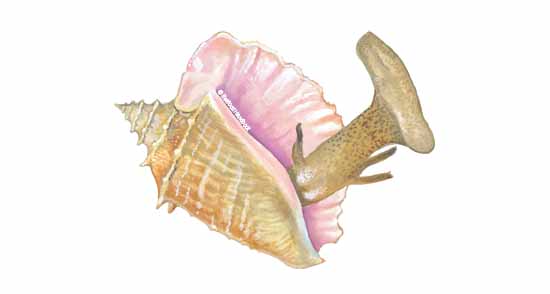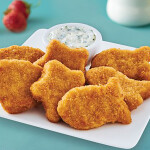Conch
Published on
January 23, 2014

Don’t confuse this large, warmwater gastropod with the East Coast whelk, also colloquially called conch. From the family Strombidae, the queen conch (pronounced “conk”) is found primarily in the Caribbean, where it uses a muscular foot to drag itself along the ocean floor. Once abundant, conch now is endangered, and commercial harvesting is banned in the United States. Major suppliers are Jamaica; Turks and Caicos Islands, which also exports farmed conch; Honduras; and the Dominican Republic. There’s an abundance of conch in the Bahamas, but it can be exported only as value-added products. Wild-caught conch is usually sold as frozen meat. Farming has made live and fresh product available. Whole, in-shell conchs range in size from 2 to 4 pounds. Both meat and shell are prized. When you buy conch meat, you get the foot. It is available at various degrees of cleaning (50, 85 and 100 percent cleaned of viscera), and prices vary accordingly.
Strombus gigas
Conch
Queen conch, Bahamas conch, Caribbean conch, pink conch
Lambis
Schneckenmuschel
Buccina
Sazae
Bocinas
Don’t confuse this large, warmwater gastropod with the East Coast whelk, also colloquially called conch. From the family Strombidae, the queen conch (pronounced “conk”) is found primarily in the Caribbean, where it uses a muscular foot to drag itself along the ocean floor. Once abundant, conch now is endangered, and commercial harvesting is banned in the United States. Major suppliers are Jamaica; Turks and Caicos Islands, which also exports farmed conch; Honduras; and the Dominican Republic. There’s an abundance of conch in the Bahamas, but it can be exported only as value-added products. Wild-caught conch is usually sold as frozen meat. Farming has made live and fresh product available. Whole, in-shell conchs range in size from 2 to 4 pounds. Both meat and shell are prized. When you buy conch meat, you get the foot. It is available at various degrees of cleaning (50, 85 and 100 percent cleaned of viscera), and prices vary accordingly.
Conch has a sweet, slightly smoky flavor, similar to abalone or clam, and an almost crunchy texture. The meat, raw or cooked, ranges from snow-white to a pale, golden-orange, depending on size. The larger the animal, the darker the meat. Young “thin-lipped” conchs have more tender meat than larger, “thick-lipped” ones. Fresh, farmed conch is sweeter and more tender than frozen, wild conch, which can be chewy.The foot has a protective covering, called the operculum, that needs to be removed before cooking.
| Calories: | 130 |
| Fat Calories: | 11 |
| Total Fat: | 1.2 g |
| Saturated Fat: | 0.4 g |
| Cholesterol: | 65 mg |
| Sodium: | 153 mg |
| Protein: | 26.3 g |
| Omega 3: | 0.1 g |
Farmed conch cooks more quickly than wild; don’t overcook, or meat will toughen. Before cooking, tenderize conch by pounding with a meat mallet, or slice thinly. Marinate sliced conch in lime juice for two hours for conch salad, or dice for chowder. For “cracked conch,” dip tenderized steaks in egg wash, roll in flour and pan fry 5 to 6 minutes on each side.
Abalone, Octopus, Squid
- Bake
- Boil
- Broil
- Fry
- Grill
- Pate
- Poach
- Saute
- Smoke
- Steam
Live
Fresh: Meat
Frozen: Cooked meat
Value-added: Canned, Chowder, Fritters, Marinated meat
Dominican Republic, Honduras, Jamaica, Turks and Caicos





